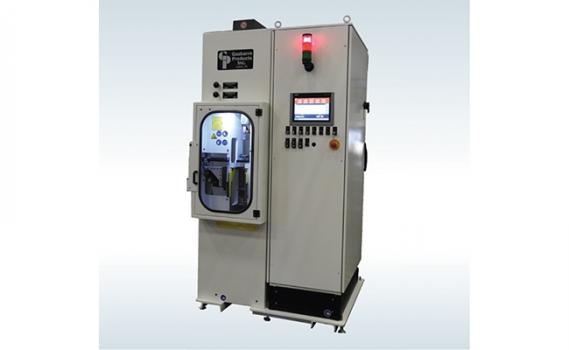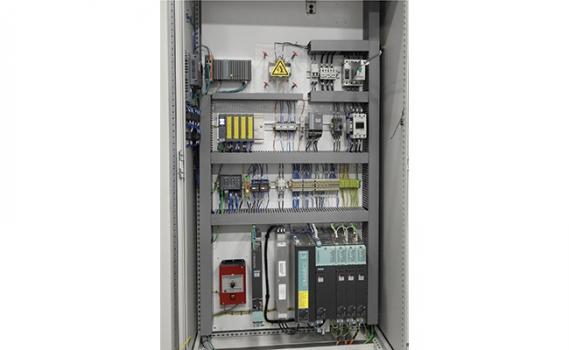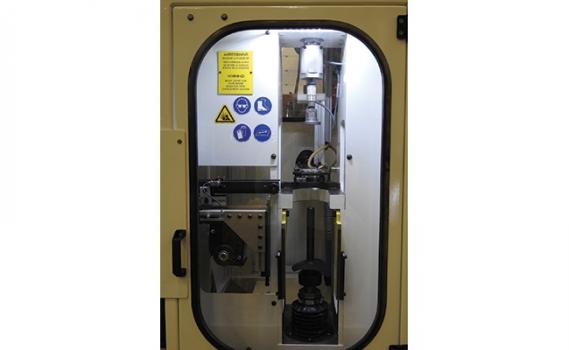Case Study: OEM Uses New Design to Speed Up Part Making
Description
In a field where hydraulic presses are standard, Gasbarre Products, Inc., an international designer and manufacturer of mechanical, hydraulic, and electric powder compaction and sizing presses, decided to re-launch its latest three-ton press using only electric servo drives. While the design had been part of Gasbarre’s strategic new-product planning, it became a reality after a customer requested a machine capable of higher performance and advanced precision.
Gasbarre focuses on primary process equipment for the powder metallurgy, particulate materials, and thermal processing industries. “While this first application was for the medical device industry, we knew other industries such as aerospace, automotive, commercial appliances, lawn and garden, and electronics components would benefit from a faster, more accurate, and cleaner electric press. In addition, a machine that could fit into the ceramic industry would just as easily work in other materials,” said Heath Jenkins, Gasbarre Vice President of Sales and Marketing.
The Gasbarre customer was looking to achieve more capacity to manufacture new products, while still maintaining the ability to meet microscopic inspection requirements. For instance, the off-the-press inspections for the ceramic parts would be performed using microscopes, not the naked eye, so a high level of precision was required. What they needed from their supplier, besides the right specifications in motion control, was a quick response to their unique and stringent technological needs.
Switching Suppliers for a Modernized and Digital Solution
Confronted with an aggressive timeline for completing the new machine, Gasbarre needed to make sure that the machine design and manufacturing phases of the project were highly efficient. Gasbarre had worked with the same traditional control equipment supplier for over 30 years. However, the servo-driven press posed new challenges that required innovation and a deep understanding of how to digitize the control process.
Larry Shindledecker, electrical design engineer for Gasbarre explains, “Our requirement for accuracy and a repeatability within milliseconds, prompted us to research what other controller equipment suppliers could offer. After performing due diligence, we decided on Siemens."
During the selection process Siemens not only delivered a unique solution to meet the customer needs, but also proved to be a invaluable resource in designing a next generation machine with tight deadlines. “Siemens made the changeover very easy,” Shindledecker said.
Siemens offered Gasbarre its intensive on-site training through the Siemens Mentoring program, which is a program designed to help OEMs build digital factory machines to secure future business. Siemens application engineers worked side-by-side with Gasbarre to help write the application software, work with the OEM group to smooth out any glitches, and assist with the design through the first machine start up. “Siemens bestowed a confidence that together we could do the job. Even after designing and manufacturing the press, Siemens’ applications support remained at a very high level,” Shindledecker said.
Expanding Capacity and Meeting Stringent Requirements
In order to fulfill Gasbarre’s Technological requirements, the new press had to transform from a traditional position movement orientation to a force movement orientation. This presented a challenge to the control system because the two movements require different operational and feedback characteristics. The shift needed to occur in hundredths of a millimeter, and high levels of repeatability needed to be maintained. Software and operational procedures also needed to be redesigned. In fact, the solution had to be able to switch positions on the fly.
Previously, this functionality was not refined enough and required an integrated solution with a third party. The major advantage to selecting Siemens as a partner in the design was that the company’s second-generation motion product and third-generation embedded motion in the PLC both have automatic transition capabilities—a critical requirement for the Gasbarre system. The importance of automatically transitioning is to provide the ability to switch from a traditional position move to a force move during the cycle. Siemens offered an off the shelf solution with their Simotion D435 motion controller.
“We chose to go with an electric servo-driven press because of the precision we’d receive using a closed-loop servo design. For each of the three servo motors used in the press, we provide multi-turn rotary encoder feedback to maintain not only the precision, but the repeatability of the press,” Shindledecker said.
For automation control, Gasbarre chose to use the Siemens SIMATIC S7-1500 Systems Controller, because they required a controller that was flexible enough to adapt to an environment of dynamic press designs. The controller also proved to be user-friendly, and offered functional integration and scalability. Controller user programs were also simple to operate and easily transferable if necessary.
The new design of the all-electric machine further benefitted the customer by offering a smaller overall footprint, lower energy usage (there was no need for a hydraulic pump to run all the time), and a cleaner environment (no hydraulic leaks). Siemen’s agility in providing a seamless transitioning technology in the servo-driven motion provided Gasbarre with the tools to respond to the industry’s needs.
Exceeding Customer Expectations
Gasbarre’s customer required high precision, while maintaining high-speed throughput. Their end user already had a tight tolerance specification of 1.5 Cpk and with the new design they were able to exceed the tolerance level by a factor of 2x. The machine also exceeded the customers mandated speed requirements by a factor of 3x. For Gasbarre, as a respected machine builder, an important goal was achieved: better parts at faster speeds, and within the limitations of a tight timeline. “Speed and tolerance typically don’t go hand-in-hand,” explained Shindledecker, “but in this case, it all came together perfectly, which was due to Siemens’ ability to respond to our urgent and immediate needs, with a high-level of engineering support.”
New Digitalization Capabilities to Expand Service Offerings
In addition to launching a new electric servo motor machine, Gasbarre wanted to develop digitalization capabilities within their new machines in order to provide additional services to their customers. Previous suppliers had indicated that their digitalization capabilities and solutions were not yet available to implement on this project. However, during their electric servo motor machine design and collaboration, Gasbarre mentioned the need for digitalization as part of their long-term strategy and Siemens was able to act quickly to the new request with digitalization capabilities that were available today.
Siemens proposed an aggressive timeline to incorporate digitalization on the current machine, which enabled Gasbarre to realize the benefits of digitalization in the current project and all projects moving forward.
Gasbarre was already utilizing Siemens Totally Integrated Automation (TIA) portal for the software platform of the electric servo-motor press, which provided a complete range of digitalized automation services, from planning and integrated engineering to transparent user operation. TIA connects Gasbarre and its customers with intelligent diagnostics for overall support, preventative maintenance, and energy management capabilities. The TIA tool also provides users with configuration flexibility through intelligent configurators and selection wizards, without having to require the expert knowledge of programming. Desktop and cloud versions provide team-wide access for maximum flexibility.
Machine Performance Setting new Standards
The new Gasbarre electric servo driven press provides customers with a new level of operational precision. The use of Siemens servo system and roller bearing actuators improves precision by a factor of 3x (from 0.0004 down to 0.00015 mm). Compared to traditional hydraulics equipment, the new solution provides not only a smaller footprint, but also a 75% reduction in energy consumption. Production rates have also improved by a factor of 3x. The new electric machine is also less noisy. Rather than the traditional 80+ dB range of traditional hydraulics systems, the servo-driven press operates in the 68-dB range. Therefore, no hearing protection gear is required, which is a safety and operations bonus. Partnering with Siemens for a digital product strategy helped Gasbarre to evolve their flexibility when designing future digitalized systems, better service their present customers, and offer machines that are fast, accurate, and less costly to operate.
Specs
Photo Captions:
- Photo 1: The Siemens D435 motion controller integrates directly with the company’s S7-1500 Systems Control to provide the combination of speed, accuracy, and repeatability for Gasbarre’s three-ton press.
- Photo 2: Gasbarre’s three-ton press.
- Photo 3: Inside the press.
- Photo 4: The right man-machine interface can make all the difference in the operator’s ability to know what’s going on with the system, and Siemens’ HMI panel was the ideal choice for the three-ton press application.
- Photo 5: Gasbarre’s three-ton press.





